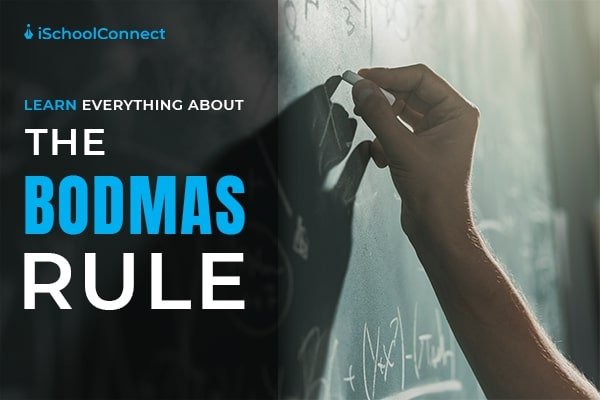Table of Contents
Mathematics is a combination of hundreds of unique and complex formulas, equations, elements, and steps that help you with your calculations. Such complex equations are simplified by the BODMAS rule in math.
You are already well versed with the basics of mathematics, such as addition, division, subtraction, and multiplication. We can solve equations that have one of these, but what to do when all of these equations come together in one single math problem. Well, that’s where the BODMAS rule comes into the picture. BODMAS is widely used in applications in mathematics, and we may use it to solve a wide range of problems.
Now, you must be having questions such as what is BODMAS or the BODMAS full form. Well, let us go through every detail one by one.
What is BODMAS?
The short form BODMAS is used to help students remember the order of mathematical operations, the correct sequence in which to go ahead and solve math equations.
BODMAS is an abbreviation of Bracket, Orders, Division, Multiplication, Addition, and Subtraction. In the USA, BODMAS is referred to as PEMDAS (Parentheses, Exponents, Multiplication, Division, Addition, and Subtraction). This method helps in explaining the order of mathematical operations that you need to follow to solve any equation.
According to the BODMAS rule, if an equation contains brackets, which can be any of the three – (),{}, [], we must first solve or simplify the bracket.
The BODMAS rule in detail!

When given an equation with a number sequence comprising more than one operation (such as 4 + 8 x 6), the operations must be done in the order of priority. This is what the BODMAS stands for:
- Brackets
- Orders
- Division/Multiplication
- Addition/Subtraction
Now, let’s take you through what each letter of BODMAS means and how you should solve equations according to it.
- The B in the BODMAS means you should complete anything that is in the brackets first and then move on to the next equation.
- The O in the BODMAS means you should apply square roots and indices after solving the bracket.
- D and M usually are put together in BODMAS, and they mean that the 3rd step is the division and multiplication of an equation. If there is more than one, then you should go through it from left to right.
- Just like the above, A and S are also used together in BODMAS. This is the last step of solving an equation. If there is more than one and both addition and subtraction in an equation, then you should go from left to right.
So, this is what each letter means in the BODMAS method; they help you solve equations with a better rate of accuracy as they follow a standard procedure that everyone in the academic and professional space is aware of.
But, what does an equation consist of?

An expression or equation in mathematics consists of two parts:
- Numbers
- Operators
Numbers
Numbers are mathematical expressions used to count and represent quantities, as well as to do calculations. Mathematics has several types of numbers. These include:
- Natural numbers
- Whole numbers
- Integers
- Rational numbers
- Irrational numbers
- Real numbers
- Complex numbers
- Imaginary numbers
Therefore, you can apply the BODMAS rule to all of these numbers and ease your calculations.
Operators
A character that combines two numbers to form an expression or equation is an operator. The most common operators in mathematics are:
- Addition (+),
- Subtraction (-),
- Multiplication (Ô), and
- Division (÷)
Finding the solution to mathematical equations with only a single operator is easy. However, it becomes difficult to find a solution when there is more than one operator.
Let us explain this with a BODMAS rule example.
Charles and Stalin worked in their own way to answer this math problem6 Ô 3 + 2.
Charles and Stalin solved the equation using two different methods; both of them are mentioned below:
Charles’ Method: 6 Ô 3 + 2 = 6 Ô 5 = 30,
Stalin’s Method: 6 Ô 3 + 2 = 18 + 2 = 20.
Charles and Stalin got answers that were different, while they had the same equation.
But, maths tells us that there can only be one answer to any equation. So, how do we find out which one is the correct answer? In such places where the answers are different, the BODMAS rule comes into play.
BODMAS conditions and rules

BODMAS comes with a set of important guidelines and methods that you need to implement accurately. You shouldn’t attempt to solve equations without keeping these rules in mind.
- a + (b + c) = a + b – c: Work on the bracket and add all the terms.
- a – (b + c) = a – b – c: Work on the bracket and multiply the negative sign with all the terms inside the bracket. (All the positive terms will be negative and vice versa in the other case).
- a(b + c) = ab + ac: Multiply all the terms outside with each of the terms inside the bracket.
If you don’t abide by these rules, it might result in some errors in calculations. So, make a note of the rules.
If you are trying to solve an equation using the BODMAS rule, then you should carefully recall, apply, and put the above-mentioned rules to good use. You can understand these rules better by referring to a BODMAS rule example.
Key Takeaways
- Mathematics is a very complex subject that involves many formulas and theorems. But, these theorems make it easier for you to calculate and find the answers to your equation.
- It is crucial to implement the BODMAS rule as it is one of the most important methods to solve equations.
- BODMAS is an excellent way to solve equations as it is a standard method to carry out calculations. As a result, you can solve math problems accurately and with ease.
So, practice solving questions with this rule and soar your maths scores. Did we miss anything about this rule? If yes, do let us know. You can drop a comment or reach out to us.
Till then, keep practicing!
FAQs
Q.1 What is the BODMAS rule and how does it help students?
Answer- The BODMAS rule helps students remember the important mathematical steps they need to follow to solve an equation effectively and get the right answer.
Q.2 Is PEMDAS and BODMAS similar to each other?
Answer- Teachers in the USA use PEMDAS to help students remember this order of operations: parentheses, exponents, multiplication, division, addition, and subtraction. On the other hand, others use the abbreviation BODMAS, which stands for brackets, ordering, division and multiplication, and addition and subtraction.
Q.3 When was BODMAS introduced?
Answer- BODMAS was introduced in the 1800s.






